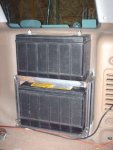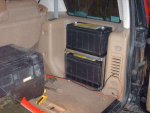You are using an out of date browser. It may not display this or other websites correctly.
You should upgrade or use an alternative browser.
You should upgrade or use an alternative browser.
New use for empty space in a D2
- Thread starter Devinchi
- Start date
Antichrist
Expedition Leader
I've thought about that for a while, as the biggest Diehard Platinum won't fit in the D1 space next to the air filter box. But I'll be using it for the winch and don't want to have to run such huge cable as I'd need from the rear.
So I'm comparing getting rid of the D1 air filter and using the old one from my D90, or relocating the winscreen washer tank, shoving the junk next to the battery back far enough to fit the larger battery, then moving the starter battery to the stock position of the jack. If I ever can find the time.
So I'm comparing getting rid of the D1 air filter and using the old one from my D90, or relocating the winscreen washer tank, shoving the junk next to the battery back far enough to fit the larger battery, then moving the starter battery to the stock position of the jack. If I ever can find the time.
R_Lefebvre
Expedition Leader
Looks like a reasonable attempt, but still makes me a bit nervous. If you haven't you should run 2 diagonals on the sides, and one at the back of the shelf legs. Just to prevent matchboxing. And I hope the floor mounts are strong enough.
Antichrist
Expedition Leader
Yeah. One battery or twenty, you only need to run cable sized for the largest load in amps (or watts) that the cable needs to carry. Now, if you're planning dual 300amp circuits, that could get expensive. :sombrero:Ya, I am dreading buying the cable to run to the back. One of these would fit in the stock location (just barely) but I figured If I am running cable to the back for one, why not for 2!!!
overlanddisco
Observer
Use welding cable for the battery cable!
When I was doing the rear mounted inverter in my D1- I shopped around and found that 0 or 00 guage welding cable will carry more amperage than the way expensive battery cables I was looking at, plus they are a WHOLE lot cheaper!
Go down to your local welding supply store and tell them what you want them for! They are usually cut to length as well, so you can get a little longer runs.
When I was doing the rear mounted inverter in my D1- I shopped around and found that 0 or 00 guage welding cable will carry more amperage than the way expensive battery cables I was looking at, plus they are a WHOLE lot cheaper!
Go down to your local welding supply store and tell them what you want them for! They are usually cut to length as well, so you can get a little longer runs.
Root Moose
Expedition Leader
There is a diagonal on the back which is tied into the old wall mounts for the jumpseat.
That's plenty strong. What is that, 1" box section? It's not going anywhere.
Last edited:
Antichrist
Expedition Leader
Yes, gauge for gauge welding cable will carry a higher current with lower volt drop than battery cable because there are more strands and so more material for the current to travel along. It still ain't cheap however.When I was doing the rear mounted inverter in my D1- I shopped around and found that 0 or 00 guage welding cable will carry more amperage than the way expensive battery cables I was looking at, plus they are a WHOLE lot cheaper!
R_Lefebvre
Expedition Leader
Yes, gauge for gauge welding cable will carry a higher current with lower volt drop than battery cable because there are more strands and so more material for the current to travel along. It still ain't cheap however.
That's not really true. When you have stranded wire, the total cross sectional area remains close to the single strand. The resistance is pretty much constant.
http://www.brimelectronics.com/AWGchart.HTM
Welding cable is nice however, because the high strand count makes it more flexible, and it often has a tough jacket.
Roverhound
Adventurer
That's not really true. When you have stranded wire, the total cross sectional area remains close to the single strand. The resistance is pretty much constant.
http://www.brimelectronics.com/AWGchart.HTM
Welding cable is nice however, because the high strand count makes it more flexible, and it often has a tough jacket.
Wrong again Rob. Current carrying capacity is also determined by temperature rating and insulation type among other things.
Antichrist
Expedition Leader
Yes, if you're comparing stranded to a single strand wire (solid conductor) but I'd have exactly zero interest in using solid conductor wire in such an application.That's not really true. When you have stranded wire, the total cross sectional area remains close to the single strand. The resistance is pretty much constant.
The welding cable I use, Carol Vu-Tron, has 2640 strands in 1/0 cable. Compared to 214 strands for a typical 1/0 battery cable. The battery cable is going to have more air space in it.
Technically true when talking about current carrying capacity, but when measuring resistance insulation/temperature rating don't come in to play. Only when a load is applied.Wrong again Rob. Current carrying capacity is also determined by temperature rating and insulation type among other things.
edited to correct the no. of strands in 1/0 Vu-tron
Last edited:
Roverhound
Adventurer
Yes, if you're comparing stranded to a single strand wire (solid conductor) but I'd have exactly zero interest in using solid conductor wire in such an application.
The welding cable I use, Carol Vu-Tron, has 1026 strands in 1/0 cable. Compared to 214 strands for a typical 1/0 battery cable. The battery cable is going to have more air space in it.
Technically true when talking about current carrying capacity, but when measuring resistance insulation/temperature rating don't come in to play. Only when a load is applied.
Why are we measuring resistance?
R_Lefebvre
Expedition Leader
Wrong again Rob. Current carrying capacity is also determined by temperature rating and insulation type among other things.
Next time you want to pick nits, make sure you're paying attention. I said resistance, not current capacity.
Why are we measuring resistance?
Because we're talking about voltage drop across the length of wire from front to back. The amperage of a 0 gauge cable is 245, and that's continuous, something we would never due. Car guys always overdo the amperage rating because we're more interested in the voltage drop. When you're only working with 12V, every volt counts.
es, if you're comparing stranded to a single strand wire (solid conductor) but I'd have exactly zero interest in using solid conductor wire in such an application.
The welding cable I use, Carol Vu-Tron, has 1026 strands in 1/0 cable. Compared to 214 strands for a typical 1/0 battery cable. The battery cable is going to have more air space in it.
No, it doesn't matter. The definition of the gauge size doesn't apply to the OD of a stranded wire. 0 Gauge stranded wire must have the same (or slightly more) cross sectional area of copper as a solid wire would (there's a few exceptions there I can't explain, I don't deal in the standards, just build the machines). You can also see that by looking at the weight/foot on the table I posted. There are minor differences due to how closely they can match up a strand count with a strand gauge to give that minimum cross sectional area. Sometimes the permutation requires them to go a little over on a stranded wire. Differences in the "amount of air" in the cable has a lot to with how they cable it, or bunch it, in some cases. Bunching is just when you drag all the strands through a closing die before insulating it. You get a bit more random pattern that way and "more air" but still the same amount of copper. Or, we actually make "compressed" wire where a low-strand-count conductor is drawn through a compressing die and there is very little space between the conductors because they all get compressed into the spaces.
Antichrist
Expedition Leader
We're talking about welding cable vs battery cable here. For that, and general automotive accessory wiring, the type of insulation is going to have minimal, probably unmeasurable, effect on the load capacity of wire when comparing the number of strands per circular mill.Why are we measuring resistance?
In fact, using welding cable will cause insulation to be even less of a factor for heat retention, since it will have lower resistance and therefore less volt drop leading to temperature rise.
For general low voltage wiring in a car, concerns about insulation type are more properly, IMO, directed towards abrasion resistance, solvent resistance, temperature resistance to external heat sources and other environmental factors.
If you size the wire properly based on volt drop, insulation type is a non-issue relative to conductor heating. At least that's how I do it, and I've never had a wiring problem due to overheating with anything I've ever wired in a car.
Forum statistics
Members online
- Oyster9
- 60toyetero
- uglybaby
- The Norseman
- shouldaboughtahat
- jethro5
- lokoh
- GXPlore!
- madrollaz
- bstock1
- jp510
- frozenchicken
- unreng
- LeeGro
- RidgeHiker
- Savagenut
- MattAune
- Imgoingonanadvencha
- llamalander
- Greeney81
- motorman
- aaldape
- dstefan
- Northern Tundra
- st22
- Jtracy
- Luinil Explorations
- Danny_D
- Lee
- joefromsf
- nakarsten
- SilicaRich
- Peter_n_Margaret
- BritKLR
- Madweld
- joestaley@gmail.com
- Gert413
- Blackwater
- kmh
- Mooneyed
- whith
- Hansville
Total: 812 (members: 52, guests: 760)


